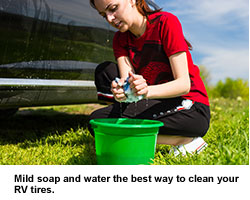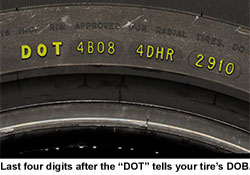
| |
|
In our previous tire reports, we discussed some of the key things to look for when taking your RV out of storage. Here are some dos and don’ts related to your tires. DO check your tires’ current inflation levels. Tires can lose up to two pounds of air pressure a month just sitting around. Unless you’ve compensated with more inflation when you put your unit in storage, the tires are likely a bit underinflated now. DO drive your RV around a bit to even out flat spots. After some months of sitting unmoved in the same spot, and possibly with a load of “stuff” still inside, your tires will likely develop “flat spots” where they have been pressing into whatever surface they’re on. So when you first take your RV out of storage for a drive you may find your ride a little bumpy for the first dozen miles or so, until the rolling heat evens them out. DON’T keep driving if you keep feeling the bumps. If you continue to experience a bumpy ride after 12-15 miles, you might want a service center to check your tires in case there is a serious problem. I always say, better safe than sorry. DON’T use petroleum-based cleaners or special dressings on your tires (the hard stuff). YOU could be making your tires vulnerable to damage from ozone and UV rays if you are using petroleum- or alcohol-based cleaning agents, silicone oils or tire dressings, all of which can dissolve the same protective tire coatings used to block ozone and UV rays (see my last eBlast for more info). So your good-intentioned cleaning can be causing more harm than good! We will talk more about tire inflation and loading your RV in future reports. But our next report will talk about something everyone driving an RV should know: How to safely drive through a blowout. Safe travels, Rudy. |
You are receiving this email because you have asked to receieve industry related product and service announcements from Dicor Products. If you would no longer like to receive these emails you may unsubscribe at any time using the link below. |
 DO clean your tires with soap and water. I’m sure one thing you’ll be doing to prepare for RVing season is cleaning the exterior; including making those tires look brand new. The safest and cheapest way to clean your tires is with mild soap and water. Stay away from the hard stuff!.
DO clean your tires with soap and water. I’m sure one thing you’ll be doing to prepare for RVing season is cleaning the exterior; including making those tires look brand new. The safest and cheapest way to clean your tires is with mild soap and water. Stay away from the hard stuff!. DO find out how old your tires are. To determine the age of your tires, one good thing is that your tires will always tell you exactly how old they are, unlike some of my friends. Your tire’s birthday is stamped right on the sidewall. Look for the last group of four numbers after the “DOT” mark embossed on the side of the tire. The first two numbers in this cluster indicate the week in the year in which the tire was manufactured, with that year noted by the second pair of numbers. So say the last four numbers are 2910. That means the tire was “born” in the 29th week of 2010. And yes, if you’re buying a used RV, ALWAYS ASK about the tires’ DOB.
DO find out how old your tires are. To determine the age of your tires, one good thing is that your tires will always tell you exactly how old they are, unlike some of my friends. Your tire’s birthday is stamped right on the sidewall. Look for the last group of four numbers after the “DOT” mark embossed on the side of the tire. The first two numbers in this cluster indicate the week in the year in which the tire was manufactured, with that year noted by the second pair of numbers. So say the last four numbers are 2910. That means the tire was “born” in the 29th week of 2010. And yes, if you’re buying a used RV, ALWAYS ASK about the tires’ DOB.

